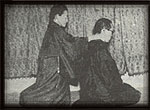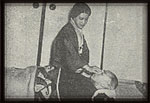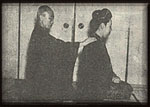
Information about the teachings of Tomita Kaiji, student of Usui Mikao



Kaiji Tomita was a student of Mikao Usui
Kaiji Tomita was a student of Mikao Usui. He wrote a book called, Reiki To Jinjutsu – Tomita Ryû Teate Ryôhô (Reiki and Humanitarian Work – Tomita Ryu Hands Healing) in 1933. The book was re-published in 1999 with the help of Toshitaka Mochizuki.
Included in his book are case studies, the technique hatsurei ho (which includes the use of waka) and hand positions for specific illnesses.
The book has some great photo’s with people practicing Reiki either on clients lay ing down or sitting in seiza.
The name of his school was Teate Ryoho kai and it was taught in 4 levels – shoden, chuden, okuden, and kaiden
Techniques of one kind or another have always been used in conjunction with the system of Reiki. Hatsurei-ho is one of the early techniques. Below is a translation of this technique from that book which is much simpler than what is practised in Japan and the West today. (The chanting of waka, poetry written by the Meiji Emperor, is not practised in the modern form of hatsurei ho in the West)



Kaiji Tomita’s Book
First sit down and try to concentrate (unify) the mind and body. Choose a quiet place or somewhere comfortable where you can relax. Included in the text are 2 different readings of the word seiza. One means to sit still and is the first part of the technique the other relates to the physical action of sitting in seiza.
Seiza (lit. Japanese to sit still)
Sit in the seiza position and gasshô with the objective to gather/concentrate the energy from the heart into the palms of the hands. Hold the hands together without using force from the arms or the shoulders. Drop the shoulders and clasp the hands, joining the fingers lightly and feel the alignment of the posture. Close your eyes.
Jôshin hô (Mind purification method)
The aim of Jôshin-hô is to unify and purify the mind. Once the sitting upright is achieved, recite (in your head) some waka poetry and feel at One with its meaning.
The following are some examples of waka that can be used for Jôshin h
ikanaran goto ni ahite mo tayumanu ha
wagashiki shima no yama to damashii
asami dori sumi watari taru o hosora no
hiroki wo wo no ga kokoro tomo gana
Hatsurei hô
If you have followed the previous steps and stayed focused on the palms of your hands they start to become warm. This is what (Tomita ryû) calls reiha ?? (wave of rei). It describes the tingling sensation that is comparable to an electrical current. The heat created and the wave of rei are what constitute spiritual energy. Even if the sensations are weak at first, they should become stronger as you keep concentrating.
5 Day plan
Repeat the above steps for 5 consecutive days, and concentrate for at least 30 minutes (progressively increasing eventually reaching an hour)
Bronwen and Frans Stiene are the co-founders of the International House of Reiki and co-authors of The Reiki Sourcebook, The Japanese Art of Reiki, Your Reiki Treatment, The A-Z of Reiki Pocketbook and the Reiki Techniques Card Deck. Bronwen and Frans teach in the USA, Europe and Australia. Visit the Courses page to find a course near you.


Comments 5
Thanks for the information. I’ve hear of Tomita and entered Google to research and found this interesting site. I wonder whether there is a translation of Tomita’s book, or whether it is availabe in book stores.
Thanks
Hi Fernando,
As far as I know there is no English translation of his book. Would be nice 😉
Thank you Frans for this – a gift that goes beyond! Much love and many blessings to you 🙂
Just curiously what do the terms ‘chuden’ and ‘kaiden’ mean exactly? Are they variants (dialects) or do they mean something else? Where could I find Kanji for them?
Interestingly I know three people (one of them was born early december 2020 and called ‘Kaiden’.
As always, I look forward to the information and insights :-). Many blessings to you!
Hi Travis,
Tomita’s school was Teate Ryoho kai and he taught 4 levels shoden, chuden, okuden, and kaiden. Si these terms are grades/levels.
Cheers
Frans